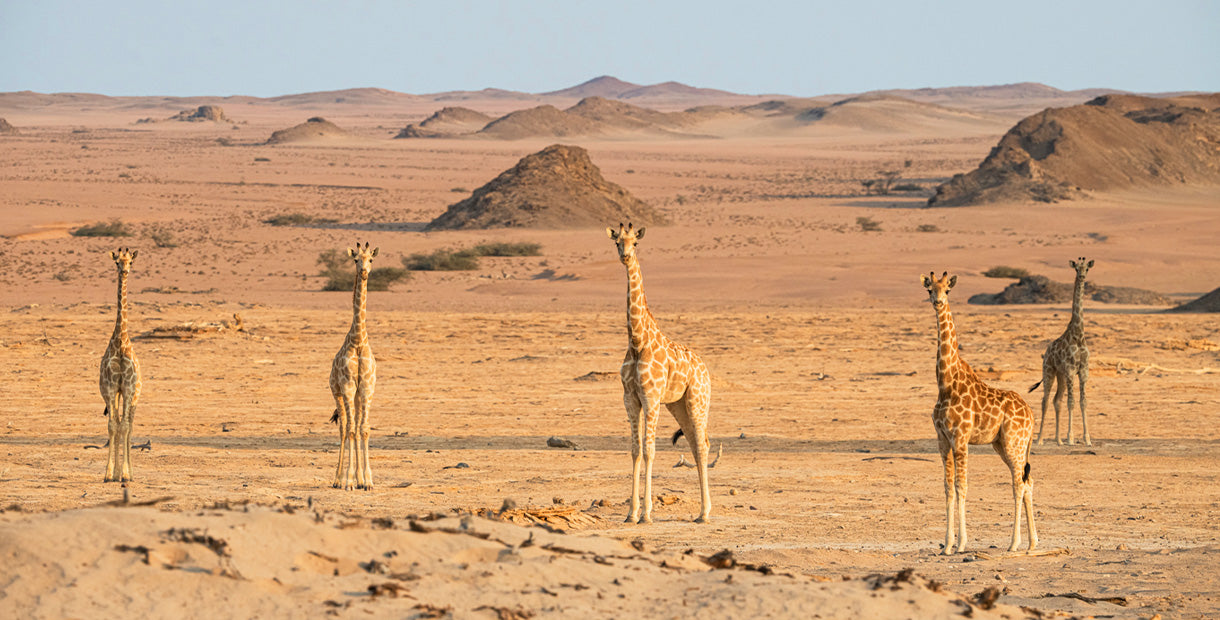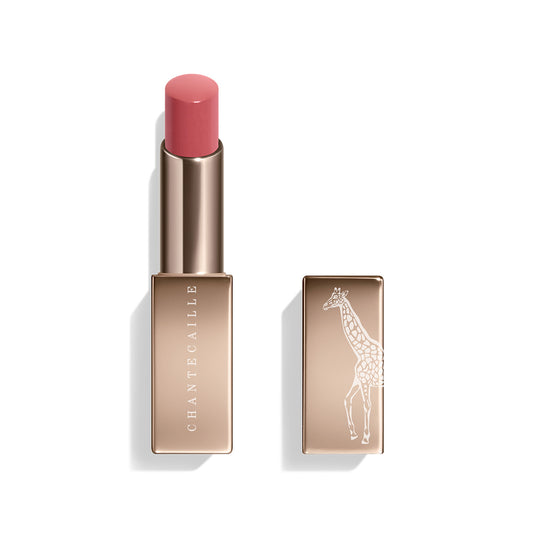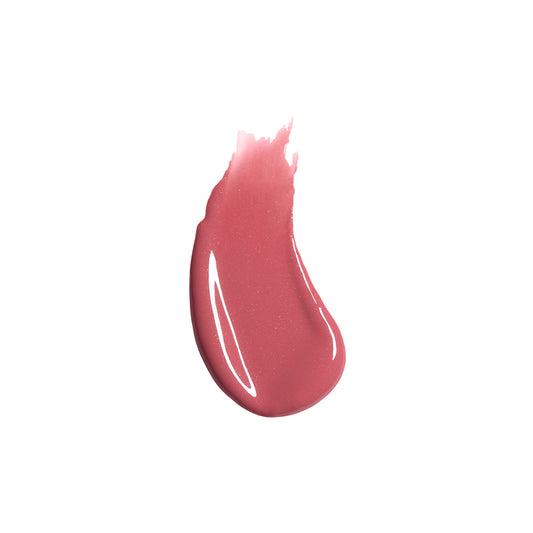
Left: Giraffes on the move in Uganda. Right: The Mozambican government has started to bring back giraffes to their country. GCF is working to bolster the small population of South African giraffes that has already been introduced to Zinave National Park in Mozambique.
Our Journey With Giraffes Continues
Chantecaille is teaming up again with Giraffe Conservation Foundation to help protect this graceful species—and bring giraffes back to Mozambique.
When we first partnered with the Giraffe Conservation Foundation (GCF) in 2019, we were shocked to learn that giraffes were enduring a so-called “silent extinction.” The gradual disappearance throughout Africa of these gentle creatures—who travel together in herds known as “journeys”—had long eluded the notice even of many conservationists, their numbers falling an estimated 30% over 30 years due to factors like human population growth, shrinking habitat, disease and poaching for their meat, hides and tails.
GCF, the only nonprofit dedicated exclusively to giraffes across Africa, sounded the alarm. Led by husband-wife team Stephanie and Julian Fennessy and based in Namibia, GCF uses scientific findings to bring innovative approaches to saving giraffes in the wild, working alongside African governments, partner NGOs, and local communities in 16 African countries. But they also tell a more hopeful story about the combined power of conservation efforts and scientific data collection that have started to turn things around for this leggy mammal. With our limited-edition Giraffe Collection, Chantecaille is proud to team up once again with our friends at GCF and help give a voice—and a future—to giraffes in Africa. We caught up with Stephanie in GCF’s headquarters in Windhoek, Namibia.
How are giraffes generally faring today in Africa?
We are currently working in 16 African countries and no two countries are the same—nor is the situation of giraffes in each of these countries. You can’t even generalize between the four species of giraffe—they all face different challenges, and some populations are doing better than others. So, we recently compiled all the survey data we have access to, and our latest estimate is that there are roughly 117,000 giraffes in all of Africa. That is still only 3 to 4 African elephants for every giraffe, but the good news is that this is certainly an increase from the 2015 estimate, which was the baseline for the IUCN Red List assessment [which ranks a species’ threatened status]. Some populations are indeed increasing due to good conservation management, strong partnerships and, more often than not, the involvement of our GCF team. We have doubled some populations single-handedly, by simply counting them better. So, more interest in giraffes and improved survey methods also play a role. However, overall, this is excellent news, as it shows that GCF’s partnership approach is working! Together we #StandTallForGiraffe and we are making a difference!

Left: The South African giraffe is a subspecies of the Southern giraffe. Right: GCF runs the largest environmental education program in Namibia. Most of these children see their first giraffe when participating in the program.
Tell us a few things about giraffes that aren’t super well known.
Many people still don’t know that there are four different species of giraffe! That is kind of important to know if we want to save them in Africa. There are the northern giraffe, southern giraffe, Masai giraffe and reticulated giraffe.
A few other things: We call giraffes opportunistic drinkers—they happily drink water when it is readily available, but can survive without open water for long periods, and some giraffes never drink. Their digestive system is super-efficient, and they can get enough moisture from their food—even in the desert-environments of Namibia. And giraffes have what is called fission-fusion bonds, which means they get together in groups and split up and might meet up again later, but mothers and daughters show stronger bonds and often stay together. These fission-fusion bonds also mean that when we move giraffes, they quite easily make new friends if we didn’t pick their besties. We see great breeding successes after translocations—this shows that if conditions are good for giraffes, their numbers increase rather quickly—at least, as quickly as possible with a gestation period of 15 months.
Our partnership with GCF began nearly three years ago, with our Vanishing Species Luminescent Eye Shade. Can you catch us up on any major giraffe conservation wins since then, and GCF’s role in them?
GCF remains the only organization in the world that concentrates solely on the conservation and management of giraffe in the wild throughout Africa. So, if there is anything happening with regards to giraffe conservation in Africa, chances are high that GCF is involved. Our work has an impact on more than 100 million acres of giraffe habitat. In the last three years, through giraffe translocations, we have reclaimed or augmented over 3 million acres of giraffe habitat. Overall giraffe numbers are on the rise and GCF is proud to have played a role in this.

These desert-adapted Angolan giraffes survive in the harsh landscapes of Northwest Namibia.
How did the GCF team manage during these last two very stressful years? Have there been any silver linings?
GCF is a small but passionate team of people, and we are based in six different African countries. While international and, at times, even regional movements were restricted, most of our field work could continue with little to no impact. Some of our staff spent more time in the field than pre-Covid to avoid lockdowns. So, overall, most of our programs continued with small adaptations.
In Namibia, we run the largest environmental education program for children. Pre-Covid, we hosted, on average, between 2,500-3,000 primary school children for a fun and educational day in the field every year. School closures and lockdowns brought this program to a rapid halt. However, our team did not sit idle; they started filming their own environmental education videos that they shared on social media and directly with teachers and pupils in Namibia. The videos were so popular that they were later professionally produced by a local TV station and shown on an education channel throughout Africa.
“This series of translocations will more than double the population, re-establish southern giraffe within their historic range and open over 3 million acres of prime habitat for giraffe to thrive!”
Tell us about GCF’s exciting partnership with Peace Parks in Mozambique.
We are planning to bring giraffe back to Mozambique in a big way! After years of civil unrest, wildlife numbers in Mozambique are precariously low—we estimate that there are only about 250 giraffes remaining in the country. We’re now planning our most ambitious giraffe translocations ever! Over the next 5 years, together with the Mozambican government, South African National Parks, Peace Parks Foundation and other partners, we are going to move over 350 giraffes to four key areas in the country: Zinave and Banhine National Parks, Maputo Special Reserve and Karingani Game Reserve. This series of translocations will more than double the giraffe population in Mozambique, re-establish southern giraffe within their historic range and open over 3 million acres of prime habitat for giraffes to thrive!
How might Chantecaille’s donation have an impact there?
Our Mozambique program is not only challenging logistically, but it also requires a considerable financial commitment. This program can only be made possible with the support of many different donors, and Chantecaille will be one of them. We could not do it without this support.
Shop The Story








